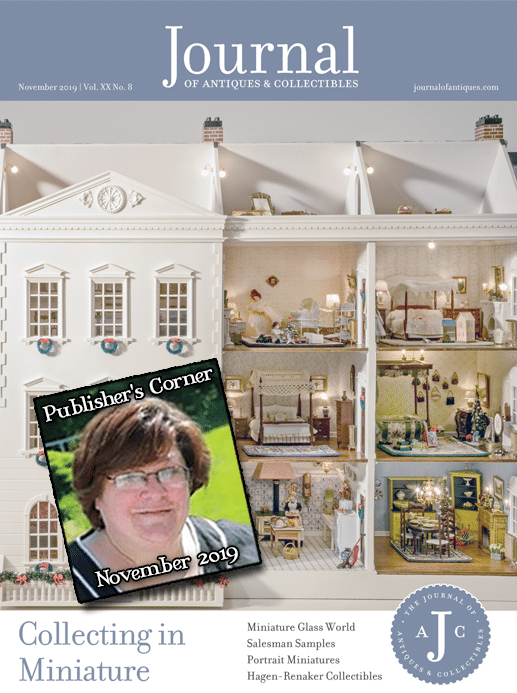Living in a Miniature World
by Maxine Carter-Lome
Recently I read Bill Dedman and Paul Clark Newell, Jr.’s book Empty Mansions (Ballantine Books, 2013), the amazing story of William A. Clark (1839-1925), one of America’s lesser known Gilded Age industrialists, and his recluse daughter, Huguette Clark (1906-2011), who became one of the greatest 20th century collectors and patrons of miniature craft. How appropriate for this issue!
While her father Senator W.A. Clark built on the grandest scale possible for his day (the family’s home on Fifth Avenue and Seventy-Seventh Street was dubbed “the most remarkable dwelling in the world” at the time it was built in 1911 for an estimated cost of $7 million), Huguette’s passion for building a vision focused on a much smaller, some would say miniature, scale. Both father and daughter built extravagantly without regard to money, but while the home William Clark built for his family is no longer there, Huguette’s miniatures live on, as does her story.
Huguette, a recluse who spent the last 20 years of her life by choice in a hospital room rather than the 42-room Fifth Avenue apartment she owned across town, had two main passions in her life – dolls and miniatures – and spent vast sums of money on both. One of her Japanese miniatures, for example, required getting special permission from the Japanese government to use rare cedar reserved solely for imperial buildings. She spent $80K to get it built. “You could call them dollhouses, but they were really historical art projects,” Dedman is quoted as saying in interviews.
Clark’s miniature houses came in two main varieties: storybook and historical. For the former, she commissioned a dollhouse maker in Germany to build tabletop dioramas depicting the best parts of fairy tales such as Rapunzel, Sleeping Beauty, and Rumpelstiltskin. Roughly the size of a desktop printer, they were, as Dedman writes, “story houses, theaters with scenes and characters painted on the walls. … religious houses with Joan of Arc, forts with toy soldiers, cottages with scenes from old French fables, and house after house telling her favorite fairy tales.”
Said Dedman, “She was demanding of her dollhouse artisans. She paid them exorbitantly, but every inch was vital—she once called up one of her dollhouse employees in a panic: “The little people are banging their heads!”—and every window shutter mattered. Cable records to her master builders, some of which were 4,000 miles away, reflect this insistence for perfection:
“Rumpelstiltskin house just arrived. It is beautifully painted but unfortunately is not same size of last porridge house received. … Please make sure religious house has front of house 19 3/4 of an inch wide. Would also like shutters on all the windows. Would like another Rumpelstiltskin house with same scenes with scene where hay is turned to gold added as well as scene before hay is turned but with wider front and also wooden shutters on every window.”
These miniatures were commissioned as works of art and were never played with and only briefly seen. Huguette had no children. Once received and admired, her dolls and miniatures were stored on a floor in her apartment building, where she retained two employees to take care of the doll clothes (many custom-made for her by Christian Dior) and manage and curate her collections, all of which she micro-managed from her hospital bed. Many of the dolls from her spectacular collection will be going up for auction in January through Theriault’s.
Dollhouses fascinate the young and old equally. Those that replicate real places and eras are miniature time capsules and works of art, such as those commissioned by Huguette Clark and the one on our cover, courtesy of Winterthur.
Nancy B. McDaniel was an interior decorator and collector who was well-acquainted with Winterthur. Inspired to create her own doll mansion after viewing Queen Mary’s Dolls’ House at Windsor Castle in England, Nancy ultimately created her “dream house” in much the same way that Henry Francis du Pont did, albeit on a smaller scale. Her keen eye for meticulous detail and design inspired a collection of more than 1,000 intricate miniature objects that now fill this prized possession. In recognition of the sympathetic vision that Nancy and H. F. du Pont shared, Nancy’s custom-crafted dollhouse was gifted to Winterthur in 2015.
One could say the dollhouse built in 1924 for Queen Mary by the architect Edwin Lutyens was what sparked the market for miniatures in America. Built on a 1:12 scale, the Queen Mary dollhouse features thousands of objects made by leading artists, designers, and craftsmen of the 1920s. There’s a well-stocked library and wine cellar, a garden, a toy theatre, and about 1000 works of art, as well as running water, electric lighting, working elevators, flushing toilets, and a miniature working bicycle. The dollhouse is on display at Windsor Castle in England and continues to be a popular tourist attraction.
Today, dollhouses come pre-made or in kits, and furniture is mass-produced, but the ability to design and create a unique vision in miniature keeps this craft as popular with new generations as it was with children and adults over a century ago, a testament to the enduring charm and craftsmanship of miniatures.
-
- Assign a menu in Theme Options > Menus WooCommerce not Found





Related posts: